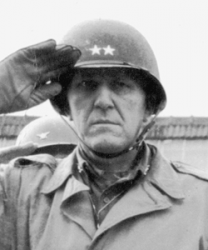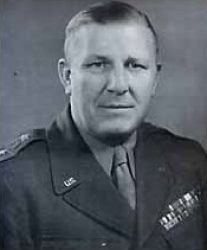
 |
|
|
||
|
John Ernest Dahlquist |
||||
|
Engagements: • World War II (1941 - 1945) |
||||
| Biography: | ||||
|
John Ernest Dahlquist John Ernest Dahlquist was born on 12 March 1896, in Minneapolis, MN. He graduated from the University of Minnesota and received a direct commission as a Second Lieutenant of Infantry in the U.S. Army in 1917. So it was as a young lieutenant that he served in the Occupation Forces in Germany after World War I. Dahlquist served as an instructor at the U.S. Army Infantry School from 1924-28. After graduating from the Command and General Staff School in 1931, he was assigned to the Philippines and remained there until 1934. In 1935-36 he was a student at the Army War College and, after graduation, served on the Army General Staff, Personnel Division, until 1941. Before the shadow of World War II appeared, he became a qualified air observer. In 1942, with America's entry into World War II, Dahlquist, then a Brigadier General, was appointed Assistant Chief of Staff in General Dwight D. Eisenhower's European Theater of Operations in England. Later that year, he became Assistant Division Commander of the 76th Infantry Division. In June 1943, Major General Dahlquist became the first Commanding General of the 70th Infantry Division, and he remained with that division until July 1944. An energetic, but relatively inexperienced, Major General Dahlquist took command of the 36th Infantry Division a month before the 15 August 1944, invasion of Southern France as part of the 6th Army Group in Operation Dragoon. He led the 36th Division 'T-Patchers' (the Division's shoulder patch is an arrow containing a large 'T') through that successful venture and the drive that followed. On 24 October 1944, the 1st and 2nd Battalions of the 141st Infantry moved to secure the right flank of the 3d Infantry Division, near the French town of St. Die. When the German forces counterattacked, 1st Battalion was separated and cut off and it came to be called the 'Lost Battalion.' After two days of attempted rescue by the 2nd and 3rd Battalions, 141st Infantry, Dahlquist resorted to sending in the mostly Japanese-American 100th Battalion, 442nd Regimental Combat Team (100/442d RCT), which had borne the brunt of the Division's fighting for the previous eight days. The 100/442d RCT would suffer 800 casualties, including 121 dead, during the five days it took to rescue the 211 men of the 1st Battalion, 141st Infantry. Tireless in battle, Dahlquist roved from point-to-point to spur on his front line units. He once saw his aide, Captain Wells Lewis, killed beside him while leading the attack to relieve the 'Lost Battalion' in the Vosges Forests. Dahlquist received the greatest criticism of his career for what some perceived to be the 36th Division's over-utilization of the 100/442d RCT. Whether good, or bad, his decisions resulted in the 100/442d RCT becoming the most highly decorated unit in the history of the U.S. military. However, it is the Caucasian officers who led the 442nd that are often quoted in criticism of Dahlquist. Many 442nd veterans felt Dahlquist was an incompetent who treated Japanese-American soldiers as more expendable than white soldiers, citing in particular their famous Rescue of the Lost Battalion.* [It is said that, at a reunion of the 442nd, long after the war ended, Dahlquist tried to shake the hand of a colonel who served in the regiment, asking that 'bygones be bygones' and suggesting that what happened between him and the regiment was 'water under the bridge.' The colonel reportedly returned his salute but refused to shake his hand.] * Side Story U.S. Senator - then Army 2nd Lieutenant - Daniel K. Inouye best describes the 442d RCT's situation following the rescue of the Lost Battalion: "When Gen. Dahlquist called the regiment out for a retreat parade to commend us personally, he is reported to have said to the Commanding Officer: 'Colonel, I asked that your entire regiment be present for this occasion. Where are the rest of your men?' And Col. Charles W. Pence, as bone-weary as any dog face in the outfit, replied, 'Sir, you are looking at the entire regiment. Except for two men on guard duty at each company, this is all that is left of the 442nd.' And there we were; cooks, medics, band, and a handful of riflemen, a ragged lot at rigid attention, without a single company at even half its normal strength. One had only 17 men and was commanded by a staff sergeant. My outfit, E Co, with a normal complement of 197 men, had exactly 40 soldiers able to march to the parade ground. Gen. Dahlquist looked at us for a long time. Twice he started to speak and choked on the overpowering feelings that took hold of him. And in the end, all he could manage was an emotional: 'Thank you, men. Thank you from the bottom of my heart.' And the saddest retreat parade in the history of the 442nd was over." The 36th Infantry Division has been recognized by the U.S. Holocaust Memorial Museum as a liberating unit for their work securing the sub-camps of the Dachau concentration camp system. By 8 May 1945, the Division was based in Kitzbühel, Austria where it captured Field Marshall Gerd von Rundstedt, the military master-mind and commander of all German army forces on the Western front. There were other, equally important prisoners: Air Marshal Sperlle, foremost exponent of dive bombing and director of the London blitz; Air Marshal Ritter von Greim, successor to Goering as chief of the Luftwaffe; Reichminister Frank, Poland's No. 1 war criminal; Max Amann, third member of the Nazi party and publisher of Mein Kampf; Leni Reifenstahl, directress of the German film industry; Admiral Horthy, regent of Hungary; and Air Marshal Hermann Goering. The 36th Division's final station was at Kufstein, Austria on 14 August 1945 and Dahlquist left the Division on 1 November 1945. Following the war, Dahlquist returned to the U.S., serving with the Secretary of War´s Personnel Board in 1945-46 and as Deputy Director of Personnel & Administration, War Department, from 1947-49. He took command of his third division, the 1st Infantry Division in 1949. This was followed by command of V Corps from 2 August 1951 to 4 March 1953. Dahlquist was promoted to Lieutenant General in 1953 and briefly given command of the Fourth U.S. Army. He then served as Chief of Army Field Forces from 1953-55. In 1955, the Army Field Forces were transformed into the Continental Army Command (CONARC). Dahlquist, who had been awarded his fourth star on 18 August 1954, continued as CONARC's Commander-in-Chief until 1956. He retired from active service in 1956. Special Note This biography earlier reported the criticism and claims of the 36th Division's over-utilization of the 100/442d RCT under Major General Dahlquist's command. It is only fair then, that the tremendous achievements of the 36th Infantry Division also be stated: After 400 days of combat, five campaigns in Italy, France, Germany and Austria, and two major amphibious operations, the men of the 36th Infantry Division-the Texas Division-could look back with pride on a multitude of victories woven with hardship and heroism. They could point to a record of 175,806 enemy captured, 12 Medals of Honor, 6 Presidential Unit Citations, 12 Distinguished Service Plaques, and a host of other commendations, medals and awards. But they could not forget that their casualty list was the third highest in the ETO: 27,343, of whom 3,974 were killed, 19,052 wounded, and 4,317 missing in action. Medals and Awards Distinguished Service Cross Honors In 1954, General Dahlquist received an honorary Master of Arts degree from the University of Minnesota. Death and Burial General John Ernest Dahlquist died on 30 June 1975. He was survived by his wife, Ruth D. Dahlquist who, coincidentally, was born 17 days after he was born, and died 17 days after he died. She was buried next to him in Arlington National Cemetery in Arlington, VA. http://www.findagrave.com/cgi-bin/fg.cgi?page=gr&GRid=47220062 |
||||
| Honoree ID: 214 | Created by: MHOH | |||
Ribbons
Medals
Badges
Honoree Photos
 |  |  |
 |  |
 |


